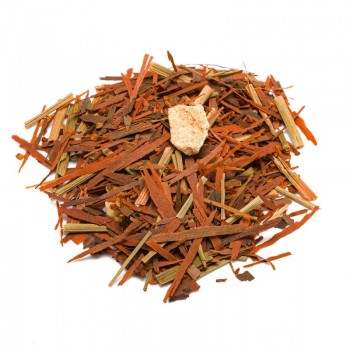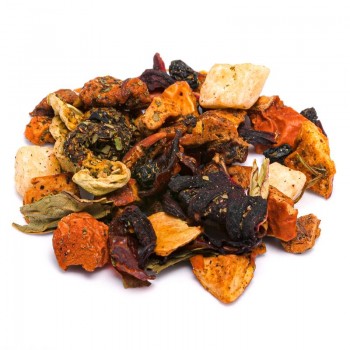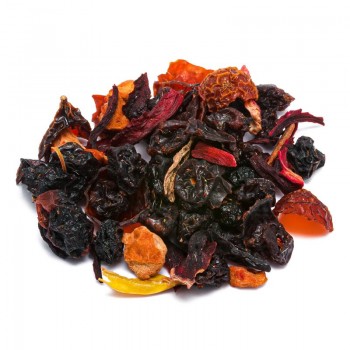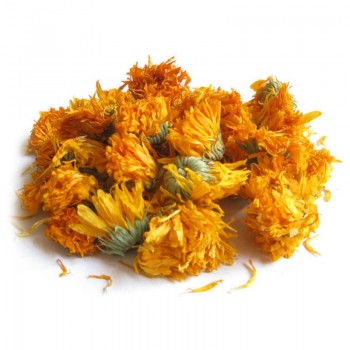Enriched with apple, pineapple, this infusion of melon and watermelon flakes represents the floral notes coming from hibiscus and elderflowers, enhanced by the vegetal nuances of sweet blackberry leaves, beetroot and yellow antennaria. The affinity of the aromas between elderflower and pineapple makes this infusion delicious and fresh, perfect in summer to quench thirst and in winter to evoke exotic and fruity aromas.
Melon and elderberry infusion: properties and benefits
The elderflower has numerous benefits for the body, used in herbal medicine for its antioxidant qualities which help the respiratory tract in case of colds and congestion. These flowers have a calming effect on the throat and nose, as well as promoting the elimination of toxins with their diaphoretic properties (which induce sweating). The combination of the infusion is also useful, in fact, for its diuretic and slightly laxative effects which promote detox action, in combination with pineapple and blackberry leaves.
Melon brings to the infusion its richness in antioxidants and mineral salts (potassium in particular), and is known for its content of vitamins, folates and beta-carotene. Vitamin C made available by melon, watermelon and hibiscus, in addition to being an antioxidant, also stimulates the immune system - it protects against colds, sore throats and nasal congestion.
Furthermore, the antennaria helps the infusion's expectorant and emollient properties for the mucous membranes. Another element that gives this vitamin and flavonoids to the infusion is the blackberry leaf, which also reinforces the antioxidant properties of the drink. Perfect for the change of season, purifying and stimulating the immune defenses, the infusion adds a remineralizing touch that is excellent for improving the intake of nutrients.
Origins and history of cultivation
Elder is a plant that shows different varieties of the Sambucus genus, related to each other. The European variety, Sambucus nigra, is native to European territory up to Türkiye. Over the centuries the plant has been introduced to most other continents of the world. North American elderberry refers to the shrub Sambucus canadensis. Depending on the species, the plants produce black-purple or red elderberries which are used for the preparation of desserts, syrups and drinks. Elderflowers have been used for centuries as a remedy to address a wide variety of ailments. In more recent times, they have played a role in the creation of cocktails and liqueurs, with their delicious flavour. In addition to elderberry syrup, they flavor drinks and desserts. Originally from Central Asia or Africa, the melon plant is today widespread with its numerous varieties in warm regions around the world. Already known 3000 years ago, the melon fruit was consumed by Sumerians, Assyrians and Egyptians. Among the Romans they were known as imported from Asia, and in a different variety. In Italy the melon was introduced more widely in the Middle Ages, from the studies of the time of Charlemagne (9th century AD). The sweet orange-fleshed variety named after the Cantalupo locality was known, where these melons were grown from a south-western Asian variety. There are many varieties but most of the melons appreciated on the table are sweet. Among the best known are netted melons (Reticulatus), cantaloupe melons (Cantalupensis), Inodorus winter melons and Chito mango melons. Some varieties can be made into preserves or pickles, dried for infusions and herbal teas. Today the major producers are Asia and Europe (Spain, France and Italy).
Fruits and flowers
Elderberry is a genus of flowering plants, which is part of the Adoxaceae family. It is divided into several species, the best known of which are the European Sambucus nigra and Sambucus canadensis. The Sambucus nigra which can grow more than 6 meters high and equally wide, developing best along roadsides and woods - the typical habitats of the species. The hermaphroditic flowers appear in late spring until mid-summer, with an ivory white color and five petals. The fruit is a shiny berry, dark purple or red in color, depending on the species. The melon comes from the Cucumis melo plant, a climber of the Cucurbitaceae family. It is a frost-resistant plant, it needs a warm climate. Shows large leaves and yellow flowers. The famous fruits are botanically a type of berry known as pepo. They can vary depending on the variety in terms of size and external shape but also in the consistency, color and flavor of the pulp. Cantaloupes and net melons are recognizable as ripe when they exude a sweet fruity odor. Winter melons ripen late, becoming softer but not too sweet. The Rose is a perennial plant of the Rosaceae family, native to Asia. There are over three hundred species and thousands of varieties in the world. It is found in the form of erect or climbing shrubs, thorny or not. The flowers change shape, size and color from white to yellow and dark red. The Malus domestica plant of the Rosaceae family is the apple plant. It is a tree native to Asia, now widespread throughout the planet. The fruits differ in many varieties in color, as well as in the consistency of the pulp and in size. The blackberry comes from the bramble Rubus Fruticosus L. and belongs to the large Rosaceae family. It grows spontaneously in Mediterranean countries as a perennial and thorny plant, forming the classic blackberry thickets. Ananas comosus is a plant of the Bromeliaceae family, which does not grow very tall. It grows best in well-drained soil exposed to the sun. The fruits have a shape that resembles a pine cone, and are formed by the union of the flowers and berries of the plant, united in a single fruit. The hibiscus plant is Hibiscus sabdariffa, of the Malvaceae family. It grows in tropical and subtropical regions around the world, used in leaves and flowers. The calyx and the flower are used as flavourings, colorants and for the preparation of hibiscus tea. Watermelon (Citrullus lanatus) is an annual plant of the Cucurbitaceae family. Originally from tropical Africa, it is now cultivated throughout the world in warm climates. The fruit, a type of berry, is known botanically as pepo. The sweet, juicy pulp can be reddish, white or yellow. Beetroot is a plant of the Amaranthaceae family, Beta vulgaris. The fast-growing vegetable can be grown anywhere and many parts are edible. The roots are used a lot in infusions - the best known are red, but there are golden and streaked varieties of beetroot. The Antennaria dioica (Mountain Sempiternus) is part of the Asteraceae family. It is a small plant, which grows along mountain paths and displays flowers with yellow protrusions.
Nutritional values of melon and elderberry infusion
The infusion is a source of minerals, in particular potassium, phosphorus and magnesium, and vitamins including Vitamin C, A and beta-carotene. How to use the ingredients in the infusion The infusion is obtained by placing approximately 3-5 grams of the melon and elderberry mixture with water at 100 °C in a cup (250 ml). Leave to infuse for 10 to 12 minutes before drinking. Add honey or sugar, if desired.
Melon and elderberry infusion: side effects and contraindications
It is necessary to respect the recommended doses and not exceed the intake for too long periods to avoid unwanted effects. Excessive consumption of the infusion can cause diarrhea, gastrointestinal disorders, stomach acidity, nausea and headaches. Caution advised for pregnant or breastfeeding women.



 No reward points for this product.
No reward points for this product.
![infuso frutti rossi [Natura d'Oriente]](https://www.naturadoriente.com/3542-home_default/infusion-of-red-fruits.jpg)










![infuso relax [Natura d'Oriente]](https://www.naturadoriente.com/3555-home_default/infused-relaxation.jpg)



